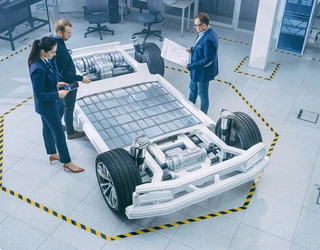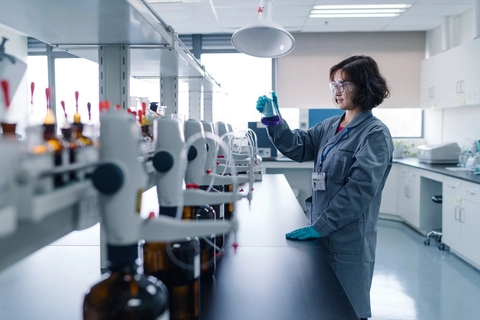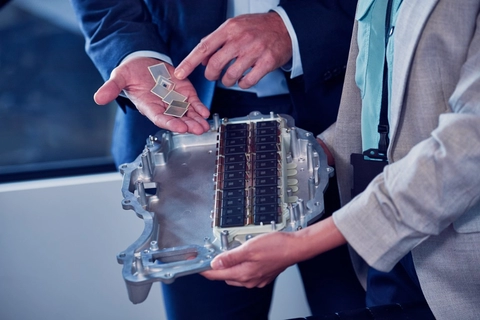
Silver service
contact us

MacDermid Alpha Electronics Solutions offers a range of products and solutions suited to the electric vehicle industry. On the one hand, the Connecticut, USA-headquartered company provides what it refers to as industrial solutions – including processes for working with lightweight materials such as aluminum and magnesium. Secondly, the company’s electronics division provides solutions for assembly and circuitry.
“It’s a combination which makes us unique,” explains Chris Klok, director of vehicle electrification technology at MacDermid Alpha Electronics Solutions. “We have product solutions for producing semiconductors, circuit boards, connectors, and all sorts of materials to assemble these.”
While MacDermid Alpha Electronics Solutions’s product and process offering remains applicable to ICE vehicles – on what Klok refers to as the signal side, with PCBs and electronics controlling, for example, the fuel and air inlet – the company’s assembly, materials, and semiconductor expertise is of particular relevance in inverter design for electric and hybrid vehicles. The design and efficiency of the inverter is vital, Klok explains, not least because of the importance of EV/hybrid powertrains in differentiating make and model performance.
“The inverter and the electric motor determine the performance and the comfort of the car,” he says. “This used to be the role of the IC engine. Other components would very often be outsourced, but the engine was almost always the OEM’s core technology. Now, all of a sudden, this role is fulfilled by the electronics.
“If [competing] vehicle manufacturers used the same inverter and electric motor, it will seem that there’s no longer any competitive advantage.”
This has led to vehicle OEMs taking on a more active role in development and production of their own electronic systems.
“You’ll see these manufacturers produce more of their own electronics,” Klok continues. “For example, you can go online and see films of various OEM factories where they are building their own electric motors, battery electronics and associated components. It’s a completely new world, and a very interesting one for us.”

Inverters are made up of power semiconductors which were usually soldered. MacDermid Alpha Electronics Solutions developed a solution, more than a decade ago, which uses silver sintering technology.
“This improves the current passthrough, hence the conductivity, by almost 40%,” Klok explains. “You can understand why this continues to attract the interest of electric vehicle manufacturers.”
The development is the latest in a series of advancements that MacDermid Alpha Electronics Solutions has made in recent years.
“If you look at electronics materials history, there are only a few examples of a revolution,” Klok says. “One example is when the semiconductor industry moved to using plating technology to cope with the needs for miniaturization. Another was the move to lead-free soldering, when we had to design new solder alloys. I believe going from soldering to sintering for power semiconductors is also a revolution.”
There are a number of OEM partner which shared MacDermid Alpha Electronics Solutions’s belief in this new technology, as Klok explains.
“I can give you an example of a supplier chain partner which used to have an inverter type that was soldered. The semiconductor devices were soldered to the substrate, and they needed over 90 of them. They updated this inverter using our sintering technology and managed to reduce the semiconductor content by 75%. That decrease meant a reduction not just in weight, but also in dimension and cost. They changed other parts as well, but the main change was going from soldering to sintering.”
They updated the inverter using sintering technology and reduced semiconductor content by 75"
One of the key advantages of MacDermid Alpha Electronics Solutions’s products and processes is that they are not limited to specific types of powertrain design.

We are what you could call independent of the powertrain configuration,” Klok explains. “Whether it’s a plug-in hybrid, a fuel-cell system or a battery electric vehicle, they all have inverters, converters, chargers and so on.” The benefits of silver sintered semiconductors can be used to address challenges of efficiency, miniaturization, thermal management and so on - both on the powertrain side and the signal side. “Basically, it doesn’t matter if it’s PHEV, FCEV or a BEV,” Klok adds. “Our technology can be used.” MacDermid Alpha Electronics Solutions continues to advance soldering technology as well, for applications in other areas of EV/HEV powertrain design. “We have some solutions for soldering that can work at very high operating temperatures,” Klok adds. “This makes it possible to use an inverter in a very small format.”
A number of the now well-established priorities for EV/HEV design – range, power, reliability, cost-effectiveness – are addressed, Klok believes, by the company’s expertise. “We recently had discussions with some senior OEM battery pack engineers,” he recalls. “They mentioned that the sweet spot is around 400km of range for an electric vehicle. If you can reduce the dimensions, reduce the weight, you make the car as efficient as possible. In this way, the OEM can reduce the amount of batteries, making the car lighter and more cost-effective while still achieving that range.”
As OEMs commit more to the development of their own electronics, Klok and his colleagues have noticed a corresponding demand for training on the kinds of materials and processes MacDermid Alpha Electronics Solutions has been advancing. “We really are in a unique position,” Klok believes.
“We have the plating side, where we treat the substrate, and the assembly side. We can support the OEM with a combination of the two technologies. That, together with the nano-based silver sinter technology – which is the most efficient type – gives us the opportunity to work very closely with the vehicle manufacturers.”
Written by Matt Ross - Electric & Hybrid Vehicle Technology International Magazine.